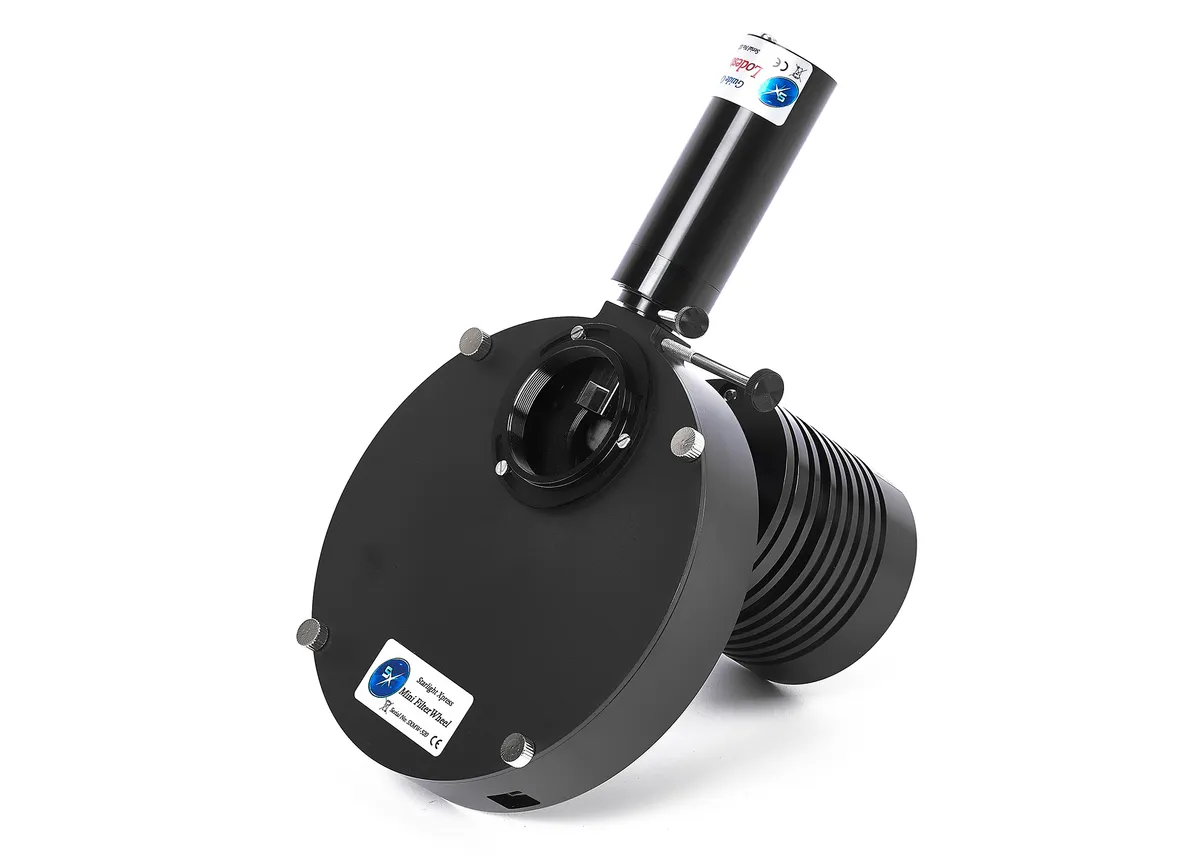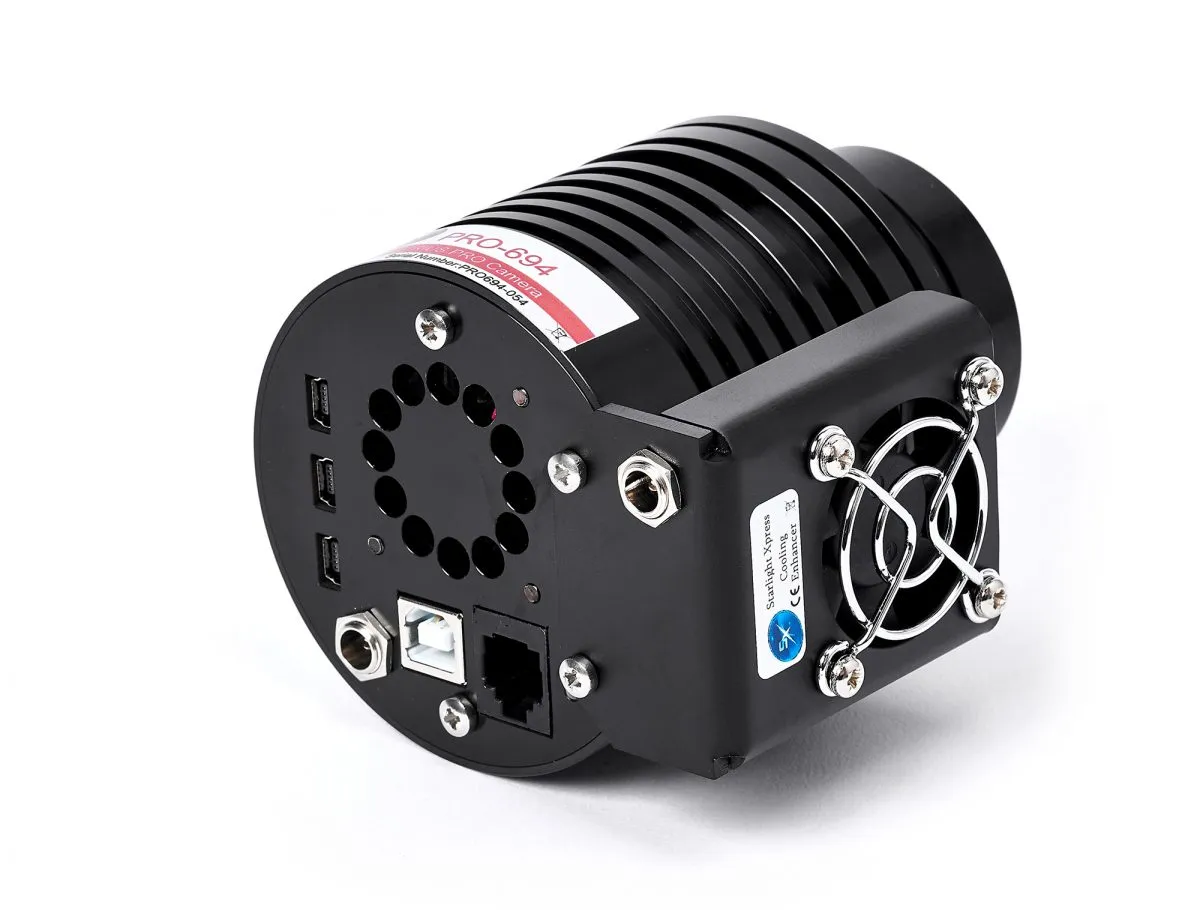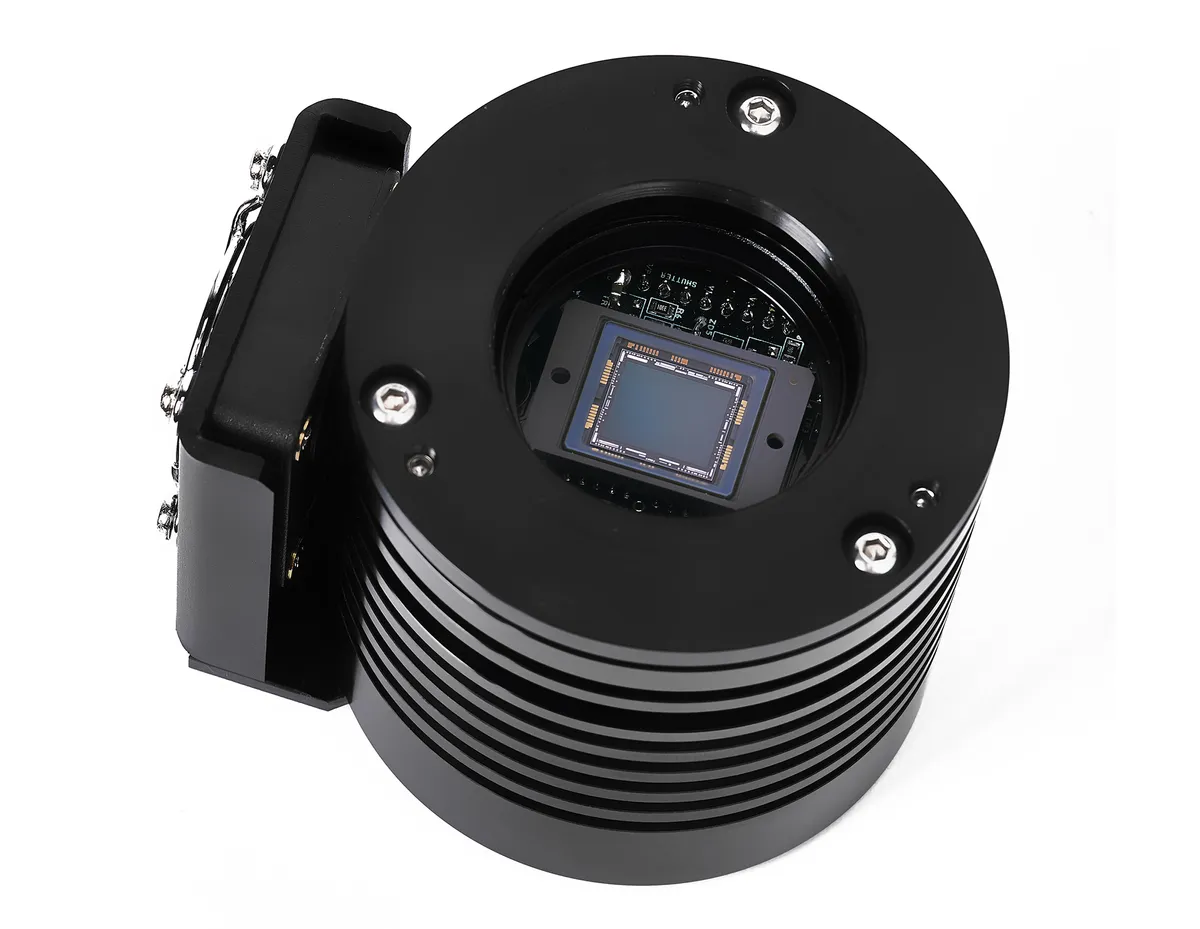Starlight Xpress has made some interesting improvements to its range of Trius cameras, which are called the Trius Pro series. In this review we are looking at the Trius Pro 694 mono bundle, which claims to contain everything you need to get you up and capturing images in one box.
The Trius Pro 694 bundle comes in a tough foam-lined case along with the Lodestar X2 off-axis guide camera and an SXMFW-1T mini filter wheel.
Also included are all the cables, a power supply, capture software and drivers for the cameras and filter wheel.
Looking at the camera on its own, the sensor is a medium-format, high-resolution EXview CCD chip, with 6,050,000 x 4.54µm square pixels in a 15.98mm diagonal array.
The sensor window is fused silica glass, which is better at dealing with any air moisture.
As well as a main high-speed USB2 port and three micro-USB ports for connecting accessories, there are two power ports to support the cooling and electronics, and a guide port is included in case it is needed in other applications.
This camera is on our list of the best cameras for astrophotography.

The Trius Pro 694 is a CCD-based camera and there is an ongoing debate about whether sensors of this type give the best image: some say that CCDs (charge-coupled devices) are being superseded by CMOS (complementary metal oxide semiconductor) sensor technology.
Both types of camera produce good images, but many astrophotographers consider that CCDs still hold up a little higher in the quality of the images they produce.
Some people argue that CCD cameras are outdated, but they are still being made by nearly all the major camera manufacturers, and in this case improved upon to give Pro versions.
As soon as you open the case you’ll be impressed by the attention given to the quality and design of the equipment; the camera is solid with a nice tough coat of paint and all the threads screw together nicely.
Assembling the equipment is easy, as the guide camera and filter wheel are already assembled in the case, so all that needs to be done is to open the filter wheel, install the filters and then screw the camera on the back.
The power supply has a splitter to plug in both ports on the camera, and the other cables for the guide camera and filter wheel are made to measure so there is nothing to catch on anything while it’s being used.

Once the camera is installed on the scope it can be controlled by most software. For our review we used Sky X Pro, which has a camera add-on that controls cameras and ancillary equipment, and we used PHD2 for guiding the equipment.
Once the main camera was focused, we set up the off-axis guider (OAG) and focused the guide camera.
Care is needed to make sure the prism on the OAG is not too low as it will show up in any image captures.
The guide camera is focused by sliding it up or down the OAG connecting shaft of the filter wheel, and it works well.
In the PHD2 program, the guide camera works best if you capture a dark-frame set using PHD2’s dark library wizard feature.
Due to poor weather conditions over the review period the only clear spells were with a bright Moon, so we opted to use a narrow-band filter set.
The Trius Pro 694 is listed in most capture software – we used Nebulosity 4 for our capture. Time was limited so we set the exposures for 3 minutes.
Our first target was part of the Veil Nebula, while on another night we had a chance to capture some data on the Elephant’s Trunk Nebula.
Then we captured a full set of calibration frames for processing in PixInsight. After processing, the images proved to be satisfactory for their capture time, revealing lots of faint detail with next to no noise (unwanted artefacts) in the background.
The Trius Pro 694 bundle has something for everyone, while it is generally a deep-sky camera for imaging all types of those objects in the night sky, it can be used for imaging the Sun and Moon as well.
The camera is Windows and Mac compatible and, with the included Starlight Live software, it allows you to stack images live as you capture them.

Superior sensor
Sony’s ICX694AL Exview CCD sensor has been around for a while, but now – coupled with the updated high-grade electronics in the camera’s new Pro version – it gives even entry-level astronomers the ability to capture high-quality images.
The specifications start with a medium-format sensor, with a pixel size of 4.54 x 4.54 microns and an image format of 2,750 x 2,200 pixels.
This is housed in an Argon gas-filled chamber that is designed for zero maintenance, meaning there is no need to change any desiccant (drying agent) over the camera’s life.
The sensor has an improved lower noise reading (3 electrons), a reduction from the original Trius SX-694 (4–4.5 electrons), while the image download time is 2.5 seconds at full resolution, so pretty fast.
The Grade 1 sensor rating means that it should contain no bad columns or dead pixels and no more than 50 hot pixels.
We did indeed find this led to high-quality frames captured and less work to do in the final processing of the images.

Delta T cooling
The camera has a Delta T cooling system which enables a temperature of –45°C and for every –5°C you halve the dark current. There are two fans built into the camera, one internal and the other external, cooling the heat-sinks built into the camera’s casing.
USB hub
The Trius 694 pro has a high-speed USB2 hub built in with three mini-B USB ports where equipment such as the filter wheel and guide camera can be plugged in directly to the camera. This cuts down on cabling with just one main cable running back to a computer to control all the equipment.
Mini filter wheel
The mini filter wheel plugs into the back of the camera and has five slots for 1.25-inch filters. There’s easy access for changing the filters with four large thumb screws on the case and the unit can be controlled from most types of capture software using the ASCOM system.
Off-axis guider
The prism for the off-axis guider is located in the top of the filter wheel. Focus on a guide star is easily attained by adjusting the two thumb screws under the guide camera. This design keeps the width small and helps with any back focus needed when using focal reducers.
Guide camera
A Lodestar X2 mono guide camera is included in the bundle and makes autoguiding a simple task. It has a Sony ICX829 sensor. There is a port for the guide cable from the mount and a USB2 socket that plugs into the main Trius camera.
Vital stats
- Price £2,550
- Camera Starlight Xpress Trius Pro 694 mono
- Sensor EXview ICX694AL
- Image format 2,750 x 2,200 pixels
- Camera size 75 x 70mm
- Filter wheel Starlight Xpress mini filter wheel
- Guide camera SX Lodestar X2
- Extras Cables, power supply and capture software
- Camera weight 400g
- Bundle combined weight 1.2kg
- Supplier The Widescreen Centre
- Tel 01353 776199
- www.widescreen-centre.co.uk
This review originally appeared in the April 2020 issue of BBC Sky at Night Magazine.